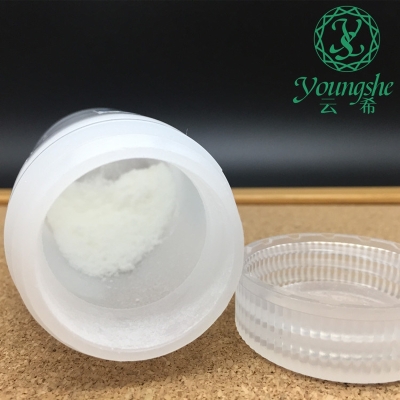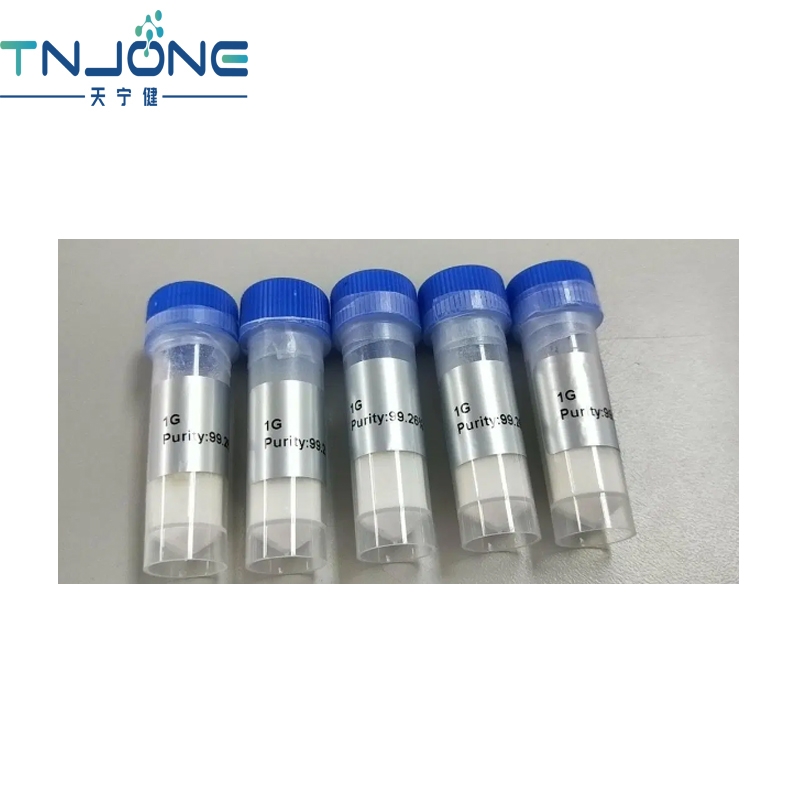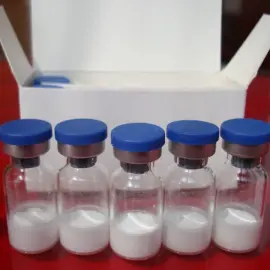Biochemical Engineering
- • Amino Acids and Proteins (221)
- • Nucleic Acid Drugs (18)
- • Enzymes and Coenzymes Drugs (115)
- • Inhibitors (1083)
- • Biological Response Modifiers (15)
- • Fat Medicines (7)
- • Amino Acids and Derivatives (4144)
- • Saccharides (2371)
- • Biochemical Reagents (322)
- • Nucleoside Drugs (346)
- • Condensing Agent (40)
- • Polypeptide (619)
- • Biosynthetic Natural Products (105)
- • Plant Extracts (813)
- • Chinese Herbs (352)
- • Microbiology Reagents (11)
- • Protein Research (34)
- • Lipids (281)
- • Inflammation Mediators (128)
Related News
Polypeptide
ALPHA-CGRP (8-37) (HUMAN)
(119911-68-1)-
![ALPHA-CGRP (8-37) (HUMAN) buy ALPHA-CGRP (8-37) (HUMAN)]()
Industrial Grade / 99.0%
-
![ALPHA-CGRP (8-37) (HUMAN) buy ALPHA-CGRP (8-37) (HUMAN)]()
-
![ALPHA-CGRP (8-37) (HUMAN) buy ALPHA-CGRP (8-37) (HUMAN)]()
Industrial Grade / 99%
-
![CGRP 8-37 (human) buy CGRP 8-37 (human)]()
Request for quotation , get quotes from more suppliers.
-
Pharma Grade / 99%
-
Research and Industrial Grade / 98.00%
-
![ADRENOCORTICOTROPIC HORMONE RAT buy ADRENOCORTICOTROPIC HORMONE RAT]()
-
![ADRENOCORTICOTROPIC HORMONE RAT buy ADRENOCORTICOTROPIC HORMONE RAT]()
Industrial Grade / 99%
Request for quotation , get quotes from more suppliers.
-
Research and Industrial Grade / 98.00%
-
Pharmacy Grade / 99%
-
Chemical Grade / 98%
$20-25/UNIT FOB
-
![GHRELIN (RAT) buy GHRELIN (RAT)]()
Request for quotation , get quotes from more suppliers.
-
- / 99.00%
-
![H-TYR-D-ALA-GLY-PHE-D-LEU-OH buy H-TYR-D-ALA-GLY-PHE-D-LEU-OH]()
Industrial Grade / 99%
-
![H-TYR-D-ALA-GLY-PHE-D-LEU-OH buy H-TYR-D-ALA-GLY-PHE-D-LEU-OH]()
-
![H-TYR-D-ALA-GLY-PHE-D-LEU-OH buy H-TYR-D-ALA-GLY-PHE-D-LEU-OH]()
Industrial Grade / 99%
Request for quotation , get quotes from more suppliers.
H-ARG-PRO-GLY-PRO-PRO-GLY-LEU-GLN-GLY-ARG-LEU-GLN-ARG-LEU-LEU-GLN-ALA-ASN-GLY-ASN-HIS-ALA-ALA-GLY-ILE-LEU-THR-MET-NH2
(202801-92-1)-
- / 99%
-
![H-ARG-PRO-GLY-PRO-PRO-GLY-LEU-GLN-GLY-ARG-LEU-GLN-ARG-LEU-LEU-GLN-ALA-ASN-GLY-ASN-HIS-ALA-ALA-GLY-ILE-LEU-THR-MET-NH2 CAS NO 202801-92-1 buy H-ARG-PRO-GLY-PRO-PRO-GLY-LEU-GLN-GLY-ARG-LEU-GLN-ARG-LEU-LEU-GLN-ALA-ASN-GLY-ASN-HIS-ALA-ALA-GLY-ILE-LEU-THR-MET-NH2 CAS NO 202801-92-1]()
Industrial Grade, Feed Grade, Food Grade, Pharma Grade / 99%
$11.11/KG EXW
-
![H-ARG-PRO-GLY-PRO-PRO-GLY-LEU-GLN-GLY-ARG-LEU-GLN-ARG-LEU-LEU-GLN-ALA-ASN-GLY-ASN-HIS-ALA-ALA-GLY-ILE-LEU-THR-MET-NH2 buy H-ARG-PRO-GLY-PRO-PRO-GLY-LEU-GLN-GLY-ARG-LEU-GLN-ARG-LEU-LEU-GLN-ALA-ASN-GLY-ASN-HIS-ALA-ALA-GLY-ILE-LEU-THR-MET-NH2]()
-
![H-ARG-PRO-GLY-PRO-PRO-GLY-LEU-GLN-GLY-ARG-LEU-GLN-ARG-LEU-LEU-GLN-ALA-ASN-GLY-ASN-HIS-ALA-ALA-GLY-ILE-LEU-THR-MET-NH2 buy H-ARG-PRO-GLY-PRO-PRO-GLY-LEU-GLN-GLY-ARG-LEU-GLN-ARG-LEU-LEU-GLN-ALA-ASN-GLY-ASN-HIS-ALA-ALA-GLY-ILE-LEU-THR-MET-NH2]()
Industrial Grade / 99%
Request for quotation , get quotes from more suppliers.
Exenatide Acetate
(141732-76-5)-
Research grade / -
-
Pharmacy Grade / 99%
-
Pharmacy Grade / 99%
$40-50/G FOB
-
Pharmacy Grade / -
$5.86-7.52/G FOB
Request for quotation , get quotes from more suppliers.
Request for quotation , get quotes from more suppliers.
-
Pharma Grade / 99%
-
![CHLOROTOXIN buy CHLOROTOXIN]()
-
![CHLOROTOXIN buy CHLOROTOXIN]()
Industrial Grade / 99%
-
![Chlorotoxin buy Chlorotoxin]()
Request for quotation , get quotes from more suppliers.
-
Research and Industrial Grade / 98.00%
-
- / 99%
-
-
![BPP 9A buy BPP 9A]()
IndustrialGrade / 99.00%
Request for quotation , get quotes from more suppliers.
CYS-TYR-ILE-GLN-ASN-CYS-PRO-ARG-GLY-NH2
(113-80-4)-
Research and Industrial Grade / 98.00%
-
![CYS-TYR-ILE-GLN-ASN-CYS-PRO-ARG-GLY-NH2 buy CYS-TYR-ILE-GLN-ASN-CYS-PRO-ARG-GLY-NH2]()
Industrial Grade / 99.0%
-
![CYS-TYR-ILE-GLN-ASN-CYS-PRO-ARG-GLY-NH2 buy CYS-TYR-ILE-GLN-ASN-CYS-PRO-ARG-GLY-NH2]()
-
![CYS-TYR-ILE-GLN-ASN-CYS-PRO-ARG-GLY-NH2 buy CYS-TYR-ILE-GLN-ASN-CYS-PRO-ARG-GLY-NH2]()
Request for quotation , get quotes from more suppliers.
Source Polypeptide Raw Materials by Region
More Information
Application of polypeptide
With recent advancements in biotechnology, polypeptides have found increasing use as therapeutic agents. They can serve in diagnostic, curative, and preventative applications and can be synthesized artificially to meet clinical demands.
Due to their unique properties, polypeptides combine the characteristics of both small molecule drugs and protein-based therapies, making them a highly researched class of molecules. Insulin, for example, was the first polypeptide drug introduced, and since then, over 80 polypeptide-based drugs have been commercialized. These include peptide vaccines, anti-cancer peptides, antiviral peptides, cardiovascular peptides, cytokine mimetic peptides, antimicrobial peptides, and diagnostic peptides.
One of the major advantages of polypeptide drugs is their reduced likelihood of inducing drug resistance. However, they also pose significant challenges, such as higher toxicity and lower stability compared to other drug types. The immunogenicity and instability of polypeptide drugs are often attributed to chemical reactions like deamidation, oxidation, hydrolysis, and the formation of incorrect structures.






























![[Arg8]-Vasotocin buy [Arg8]-Vasotocin](https://file.echemi.com/fileManage/upload/goodpicture/20210417/m20210417155050598.jpg)




